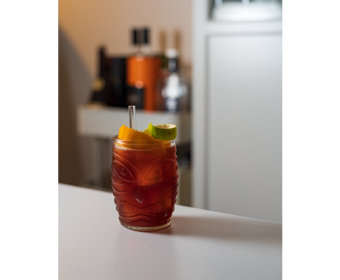In the Libertines – Teeling Distillery Visit
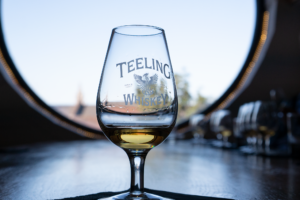
We were on holiday in Ireland for the last couple of days. Of course, we also had to visit an Irish whiskey distillery. Since I had good experience with their whiskeys, we chose the Teeling distillery in Dublin. Apart from the tour, I also had the great pleasure of bottling my very own bottle of whiskey.
The modern Teeling distillery is located in the Libertines area of Dublin and right across historical whiskey grounds. Across the street you can still see the ruins of one of the former Dublin distilleries. Once home to the four biggest distilleries and many smaller ones, Dublin had lost all of them by 1976 when the Power’s distillery closed. This means that Teeling was the first new distillery in Dublin for 125 years.
Distilling family

In 1987 John Teeling converted a potato alcohol plant into the Cooley Distillery. After the sale of the distillery to what is now Beam Suntory in 2011, John’s sons Jack and Stephen Teeling acquired a stock from the old distillery to get their own adventure on the way. In 2015 the Teeling Whiskey Distillery was finished. Just a few streets away from where Walter Teeling, a family ancestor, had opened his distillery on Marrowbone Lane in 1782.
Attention to details
After starting the tour with a short video from Jack and Stephen Teeling, our guide Eimear gave us a great tour through the production facilities. Starting at the mill, which is fed by four large grain silos, and which uses a little water for the wet milling process. There we could also experience the difference between malted and unmalted barley. Clearly, the malted barley was more spicy and more aromatic.
Mashing and fermenting

To get a mash the milled grain is cooked in the lauter tun. After that the mash is fermented in two open oak fermenters with a capacity of 15,000 l or in four stainless steel ones with a capacity of 30,000 l. The yeast used is a mixture of distiller’s yeast and white wine yeast, both coming from South Africa. At the end of the fermentation process, the wash has an ABV of around 8 %.
Three daughters – three stills
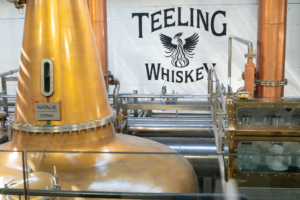
Afterwards the wash is transferred to three pot stills made by Frilli. All three of them are named after the three daughters of Jack Teeling. The first still, Alison, has a capacity of 15,000 l, while the second, named Natalie, has 10,000 l and the third one with a capacity of 9.000 l is called Rebecca. During the first distillation the low wines are distilled to around 25 % ABV. In the second run, the ABV is increased to approximately 60 %. While after the third distillation the ABV lies at about 84 %. On top of that, they also have a specific onion form reminiscent of former Irish pot stills. The spirit is then watered down to an ABV of 66 % or 67 %.
All kinds of barrels
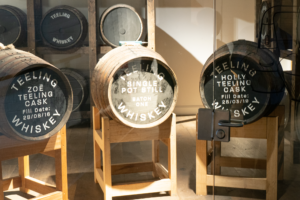
As mentioned by Eimear around 60 % of a whiskeys taste come from the barrel. At Teeling they use all kinds of barrels. Most of the whiskey, which still comes from stock distilled at the Cooley distillery, starts off as being aged in bourbon barrels. However, they also use Sherry, Madeira, Port, red and white wine barrels. The folks at Teeling even experiment with using chestnut wood. The whiskey ages one hour north of Dublin in Greenore, because of safety reasons and a lack of space. Only three barrels rest in the distillery itself, the first one ever filled and two barrels. The last two ones are named after Stephen’s daughters Zoë and and Holly.
Tasting the whiskey
When the distillery tour was over, we had the so-called Trinity tasting. We sampled the Small Batch, the Single Grain and the Single Malt. On top of that, we also tried a Riesling Cask finished bottling of the Small Batch, exclusive for the German market. The Small Batch is made from 75 % corn and 25 % malted barley. It is aged for up to six years in ex-bourbon casks and finished for six to seven months in former rum barrels from Central America. The whisky tastes sweet with overripe fruit flavours, some spices and a hint of exotic fruits. The Single Grain is distilled from 95 % corn and 5 % malted barley. It ages for six to seven years in Californian Cabernet Sauvignon casks. I especially like the Single Grain’s spicy complexity combined with fresh oak and gooseberry notes.
Single malt and Riesling cask
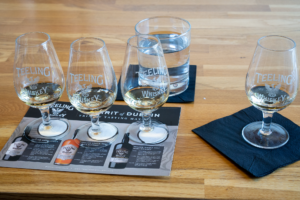
The Single Malt is aged to around ten years in bourbon barrels and then transferred to port, sherry, madeira and Cabernet Sauvignon casks for finishing. This takes place for six to 24 months and afterwards 15 % of Sherry barrel single malt from 1991 is added to the blend. The resulting whiskey is complex with dark fruits, vanilla and spices. You can also detect a certain floral note layered on top of everything. Last but not least, with the Teeling Riesling Cask the same mash-bill as the Small Batch gets a finish in Reichsrat von Buhl Riesling barrels. These special casks add funky fruit notes to the whiskey, resulting in a almost golden raisin like flavour. All of the Teeling whiskeys are non-chill-filtered.
Bottle your own
In the end everyone from our group had his own favourite of the Teeling whiskeys. All of them are exceptionally good and they cover a large range of tastes and styles. On top of everything, we had a delicious Irish Coffee using the Teeling Small Batch at Teeling’s Bang Bang Bar. All in all, we had a great time and with Eimear an excellent guide! However, probably the thing I like the most is that you can bottle your own cask strength Teeling whiskey in the shop. In my case it was a 10-year-old Sherry barrel aged one. Even when it is not what you could call cheap, the experience and uniqueness is absolutely worth it!




